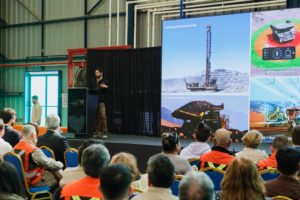Compania Minera Lomas Bayas, a Glencore company, recently celebrated its 25-year history with a ceremony held at the facilities of the operation, which included a special moment to recognise the founding members of the mining company and to present the initiatives that will chart the road along the path of operational and technological excellence.
One of the milestones announced during the event was the presentation of Lomas Lab, an R&D proposal implemented by Lomas Bayas to develop and promote various innovations and automation projects that Glencore will subsequently replicate globally, placing it at the forefront of copper mining worldwide.
Enrique Caballero, Technology Manager at Glencore Copper presenting Lomas Bayas technology initiatives

Pablo Carvallo (pictured at the start of the article), General Manager of Lomas Bayas, highlighted that: “We are celebrating a legacy and a prominent future. Twenty-five years ago, a group of people believed in a project and, after long years of hard work and dedication, today we can say that we are a leading company in low-grade copper mining. We are also very proud of the launch of Lomas Lab and the other technology initiatives that will help us to grow always putting people at the heart of our business.”
This pioneering initiative was supplemented with the announcement of the startup of the autonomous trucks and drills project, which is an improvement in terms of safety and operational efficiency. The project of trucks powered by electricity via an overhead wire (trolley), one of the most important technologies in the industry, was also presented. This project will be thoroughly studied using digital analytics metrics, to move Mining 4.0 forward in the Antofagasta region.
“We want to emphasise that the technologies we are developing include the possibility of becoming one of the first companies in the world to use autonomous trolley trucks, in line with our decarbonisation and sustainable development goals,” added Carvallo.
According to Enrique Caballero, Technology Manager at Glencore Copper, “the Lomas Lab program regards Lomas Bayas as a global learning and technology development site; in other words, the company will become an exporter of technologies, methods and models that contribute to a safe and efficient deployment of future projects at other Glencore sites worldwide. This makes Chile and the Antofagasta region knowledge and technology leaders.”
The celebration for the 25th anniversary of Lomas Bayas was attended by the employees and their families, union leaders, representatives of the leadership team and Glencore, civil society members and various authorities, who showed their deep appreciation of these announcements.
Luis Felipe Ramos, Chile’s Undersecretary of Energy, said that “initiatives such as those promoted by Lomas Bayas to achieve net zero, are aligned with the objectives of President Gabriel Boric’s Administration and with the Climate Change Framework Law to achieve the decarbonisation goals by 2050. These instances contribute employment, investment and progress in areas of the territory such as Sierra Gorda, incorporating and involving the communities and people in the benefits obtained from these developments, particularly in a region such as Antofagasta, where 60% of the energy demand comes from mining, and also set an example to be followed by other industries.”
While Willy Kracht Gajardo, Undersecretary of Mining, stated that “mining allows making in Chile what the aerospace industry makes in the United States, that is, to develop world-class technologies and solutions. In recent years and decades, mining has made an important effort to incorporate technologies and automate processes, to which it now adds the challenge of reducing emissions. In our opinion, what Lomas Bayas is doing with the launch of Lomas Lab points in the right direction, and we are interested in the replication of this exercise at other mining companies that operate in the country.”
The group of initiatives launched during the anniversary of Lomas Bayas is aligned with the values and goals of its parent company, Glencore, focused on a responsible and tangible transition to full decarbonisation by 2050, a strategic target for all its operations worldwide.
History of Lomas Bayas
Lomas Bayas dates back to 1981, when the company Minera Pudahuel Ltda wrote a call option for the property. Years later, the land was acquired by various companies, and Gibraltar Mines Ltd became its sole proprietor in 1994. After many years, transfers and overcoming great obstacles, Lomas Bayas produced its first cathode in 1998, which was quite an achievement for a mining operation that works with the lowest copper grades in the country.
This mining company attracted the interest of several economic groups over the years. In 2006 Xstrata Copper acquired the assets of Falconbridge (including Lomas Bayas), and expanded the throughput to 75,000 t/y in 2008. Xstrata merged with Glencore in 2013, and Lomas Bayas became part of this conglomerate, closing that year with a production of 74,174 t of high purity copper cathode.
Currently, Lomas Bayas stands out for its developments and contributions to the national territory, and is the mining company with the lowest copper grade that operates in Chile. Approximately 1,750,000 t of cathode have been produced between 1998 to date.
About Lomas Bayas and Glencore
Minera Lomas Bayas is located 110 km northwest of Antofagasta and at 36 km east of Baquedano. It is among the operations with the lowest ore grade (an average of 0.25%) in the national industry and extracts oxide ores from an open pit deposit.
Its annual production averages 73,000 t of fine copper in the form of high purity cathode. It ships its product through the Port of Antofagasta, and Glencore markets it directly to its customers.
Glencore is one of the world’s leading natural resource companies present in six continents, 35 countries, with more than 150 mining, metallurgical operations and oil assets. In Latin America, it has high-end operations such as Antapaccay in Peru and projects underway in Argentina.










